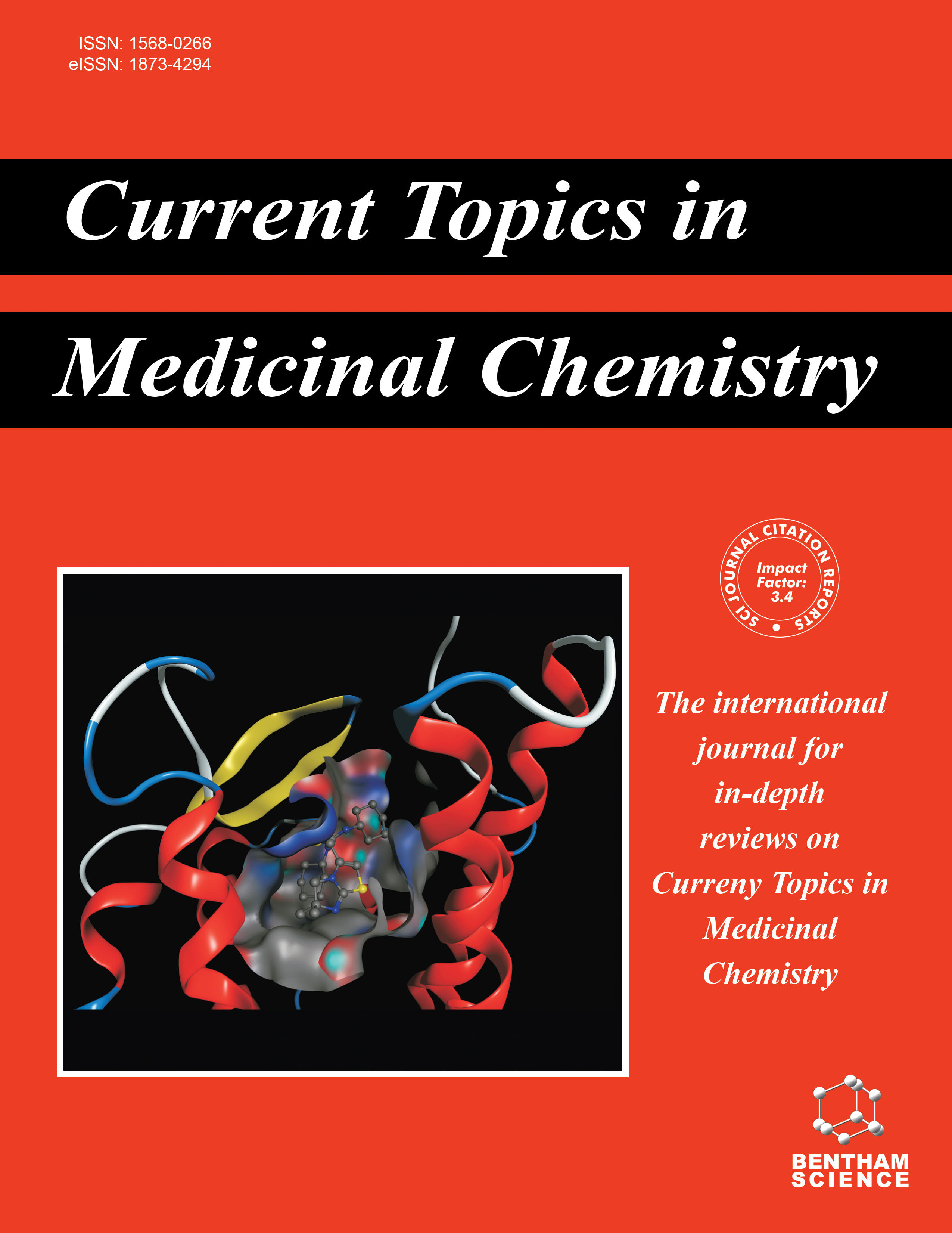- Home
- A-Z Publications
- Current Topics in Medicinal Chemistry
- Previous Issues
- Volume 4, Issue 12, 2004
Current Topics in Medicinal Chemistry - Volume 4, Issue 12, 2004
Volume 4, Issue 12, 2004
-
-
Preface [Hot Topic: Bioorganic Chemical Approaches for the Design of Protease Inhibitors (Guest Editor: Dong H. Kim)]
More LessBy Dong H. KimProteases play crucial roles for the normal functioning of biological systems. Proteins that are generated in ribosome must be degraded in order for them to carry out their functions in the biological systems and these protein degradations are catalyzed by a variety of proteolytic enzymes. A myriad of metabolic reactions involved in diverse physiological processes such as protein turnover, digestion, blood coagulation and wou Read More
-
-
-
Preface [Hot Topic: Matrix Metalloproteinase Inhibitors (Guest Editor: Jeremy I. Levin)]
More LessThe matrix metalloproteinases (MMPs) are a family of more than 20 zinc-dependent mammalian enzymes, both membrane bound and secreted, most of which are involved in the cleavage of some component of the extracellular matrix (ECM), including collagen and gelatin. Related enzyme families include the adamalysins (ADAMs) and the ADAM-TS enzymes. The discovery of these important enzymes and their physiological Read More
-
-
-
Recent Developments in the Design of Mechanism-based and Alternate Substrate Inhibitors of Serine Proteases
More LessAuthors: Jiaying Zhong and William C. GroutasA wide range of human diseases are associated with the aberrant activity of mammalian, viral, bacterial or parasitic proteases. These include members of all four classes of proteases, namely, serine, cysteine, aspartic and metalloproteases. The involvement of proteases in disease states has provided the impetus behind studies related to the design of potent and selective inhibitors and their use as either therapeutic agent Read More
-
-
-
Chemistry-based Design of Inhibitors for Carboxypeptidase A
More LessBy Dong H. KimCarboxypeptidase A (CPA) is one of the most extensively studied zinc proteases and serves as a prototypical enzyme for a large family of metalloproteases that play important roles in biological systems. CPA has been used as a model enzyme for developing design strategies of inhibitors that restrain the catalytic activity of zinc proteases. Recently, there has been made a remarkable progress in designing small Read More
-
-
-
Quest for Selectivity in Inhibition of Matrix Metalloproteinases
More LessAuthors: Stephen Brown, Samy O. Meroueh, Rafael Fridman and Shahriar MobasheryMatrix metalloproteinases (MMPs), of which at least 26 are known in humans, have been linked to a number of pathological conditions including tumor metastasis, inflammation, neurological and cardiovascular diseases. Inhibition of MMPs has been widely sought as a strategy in intervention of these disease processes. Whereas a large number of broadspectrum MMP inhibitors have been developed over the past decade, thes Read More
-
-
-
Inhibitors of 3C Cysteine Proteinases from Picornaviridae
More LessAuthors: Manjinder S. Lall, Rajendra P. Jain and John C. VederasThe Picornaviridae are among the smallest icosahedral positive-sense single stranded RNA containing viruses known, and comprise one of the largest and most important families of human and animal pathogens. The hepatitis A virus (HAV) and human rhinovirus (HRV) are important pathogens that belong to the picornavirus family. All picornaviruses have a 3C proteinase that processes an initially biosynthesized precu Read More
-
-
-
The Evolution of the Matrix Metalloproteinase Inhibitor Drug Discovery Program at Abbott Laboratories
More LessMatrix metalloproteinases (MMPs) have been implicated in several pathologies. At Abbott Laboratories, the matrix metalloproteinases inhibitor drug discovery program has focused on the discovery of a potent, selective, orally bioavailable MMP inhibitor for the treatment of cancer. The program evolved from early succinate-based inhibitors to utilizing in-house technology such as SAR by NMR to develop a novel class of biaryl hydr Read More
-
-
-
Sulfonamide-Based Acyclic and Conformationally Constrained MMP Inhibitors: From Computer-Assisted Design to Nanomolar Compounds
More LessAuthors: Stephen Hanessian and Nicolas MoitessierThe present account relates to our studies in the computer assisted design and synthesis of acyclic and cyclic MMP inhibitors. Our early efforts focused on the preparation of cyclopropane and tetrahydrofuran-based mimics of batimastat which were not active. The discovery of subnanomolar sulfonamide-based acyclic inhibitors instigated the design of novel target compounds. Thus, with the help of a fully autom Read More
-
-
-
The Design and Synthesis of Aryl Hydroxamic Acid Inhibitors of MMPs and TACE
More LessThree different classes of aryl hydroxamic acid scaffolds have been explored and provided potent inhibitors of MMP-1, -2, -9, -13 and TACE. Structure-based design has allowed the evolution of these inhibitors from broad spectrum inhibitors into compounds that are more selective for MMPs relevant to particular disease states. Aryl hydroxamates selective for MMP-9, MMP-13 and TACE have been disclosed that may aid Read More
-
-
-
The Application of X-ray, NMR, and Molecular Modeling in the Design of MMP Inhibitors
More LessAuthors: Thomas S. Rush III and Robert PowersThe following review discusses the successful application of X-ray, NMR, and molecular modeling in the design of potent and selective inhibitors of matrix metalloproteinases (MMPs) and TNFα-converting enzyme (TACE) from Wyeth. The importance of protein and ligand mobility as it impacts structure-based design is also discussed. The MMPs are an active target for a variety of diseases, including cancer and arthritis.
-
Volumes & issues
-
Volume 25 (2025)
-
Volume 24 (2024)
-
Volume 23 (2023)
-
Volume 22 (2022)
-
Volume 21 (2021)
-
Volume 20 (2020)
-
Volume 19 (2019)
-
Volume 18 (2018)
-
Volume 17 (2017)
-
Volume 16 (2016)
-
Volume 15 (2015)
-
Volume 14 (2014)
-
Volume 13 (2013)
-
Volume 12 (2012)
-
Volume 11 (2011)
-
Volume 10 (2010)
-
Volume 9 (2009)
-
Volume 8 (2008)
-
Volume 7 (2007)
-
Volume 6 (2006)
-
Volume 5 (2005)
-
Volume 4 (2004)
-
Volume 3 (2003)
-
Volume 2 (2002)
-
Volume 1 (2001)
Most Read This Month
Article
content/journals/ctmc
Journal
10
5
false
en


